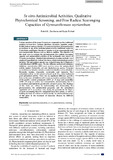In vitro Antimicrobial Activities, Qualitative Phytochemical Screening, and Free Radical Scavenging Capacities of Gymnanthemum myrianthum
Abstract
Various members of the genus Vernonia are commonly used in traditional
medicine to treat fever, malaria, diarrhoea, dysentery, hepatitis, cough,
fertility inducer and as a laxative. Vernonia myrianthum (Gymnanthemum
myrianthum) is one of the medicinal plants used by traditional healers in
Uasin-Gishu and Elgeiyo Marakwet counties to treat communicable and
non-communicable diseases such as diabetes mellitus. The objectives of
this study were to evaluate the phytochemicals, free radical scavenging
capacity and antimicrobial activities of the methanolic root extract of
Vernonia myrianthum. Standard phytochemical screening methods were
employed to qualitatively evaluate the classes of phytochemicals present in
the plant. The anti-oxidant capacity was evaluated using the 2,2-diphenyl-
1-picrylhydrazyl (DPPH) assay. The disc diffusion method and minimum
inhibitory concentration (MIC) were used to screen for antimicrobial
activity against Escherichia coli and Staphylococcus aureus. Vernonia
myrianthum was found to contain secondary metabolites such as alkaloids,
flavonoids, tannins, terpenoids, carotenoids, and coumarin. The
antioxidant activity on the extract as based on its IC50 values indicated
good antioxidant activity. There was no significant difference (p≥0.01)
between the zones of inhibition of Vernonia myrianthum and those of those
of the positive control gentamycin (GEN, at 10 mcg) and amoxicillin
(AMC, 30 mcg) at various test concentrations demonstrating that V.
myrianthum could inhibit the growth of E. coli and S. aureus. The findings
of this study are critical in understanding and documenting the
phytochemistry, the antimicrobial properties and the antioxidant
capabilities of V. myrianthum thus, laying the groundwork for future
research on isolating bioactive compounds from these plants, as well as
building the body of evidence needed to justify the ethnomedicinal usage
of this plant in the treatment of numerous diseases by different
communities.

